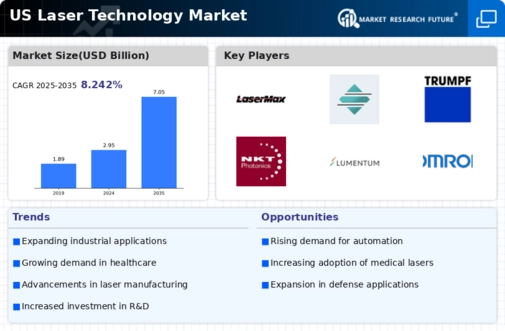The US Laser Technology Market is characterized by rapid advancements and a highly competitive landscape, which has stimulated innovation across various sectors, including manufacturing, medical, and telecommunications. As a result, market participants are constantly employing strategies such as product differentiation, mergers and acquisitions, and technological collaborations to secure their positions. The increasing demand for high-precision tools and equipment has spurred companies to enhance their offerings, leading to a proliferation of cutting-edge laser solutions. Factors driving competition include the need for high-efficiency lasers, the trend towards miniaturization, and the growing requirements for customized solutions.
As the market continues to evolve, understanding competitive dynamics will be vital for stakeholders aiming to navigate this complex environment effectively.LaserMax has established itself as a formidable player in the US Laser Technology Market through a suite of well-engineered laser products known for their reliability and precision. The company specializes in advanced laser marking solutions, which cater to diverse industrial applications, meeting the stringent demands of sectors such as automotive, medical device manufacturing, and aerospace. LaserMax's strong presence in the market is bolstered by its commitment to high-quality engineering, which ensures that its products consistently exceed customer expectations.
Additionally, the company's adeptness at finding innovative solutions to complex marking challenges has strengthened its competitive edge, allowing it to maintain a loyal customer base while attracting new clientele seeking high-performance laser technologies.Photonics Industries has made significant strides in the US Laser Technology Market with its focus on high-quality, versatile laser systems and precision optoelectronic products. The company is known for its unique offerings in the area of solid-state laser technology, which deliver superior performance in a range of applications including materials processing and scientific research.
Photonics Industries benefits from a robust market presence, backed by its track record of reliability and energy-efficient solutions. The firm continually invests in research and development, which allows it to stay ahead of competitors while also satisfying emerging industry demands. Moreover, through strategic partnerships and mergers with complementary firms, Photonics Industries has expanded its product portfolio and technological capabilities, solidifying its position in the market as a leader in laser innovations tailored for US-based customers.






















